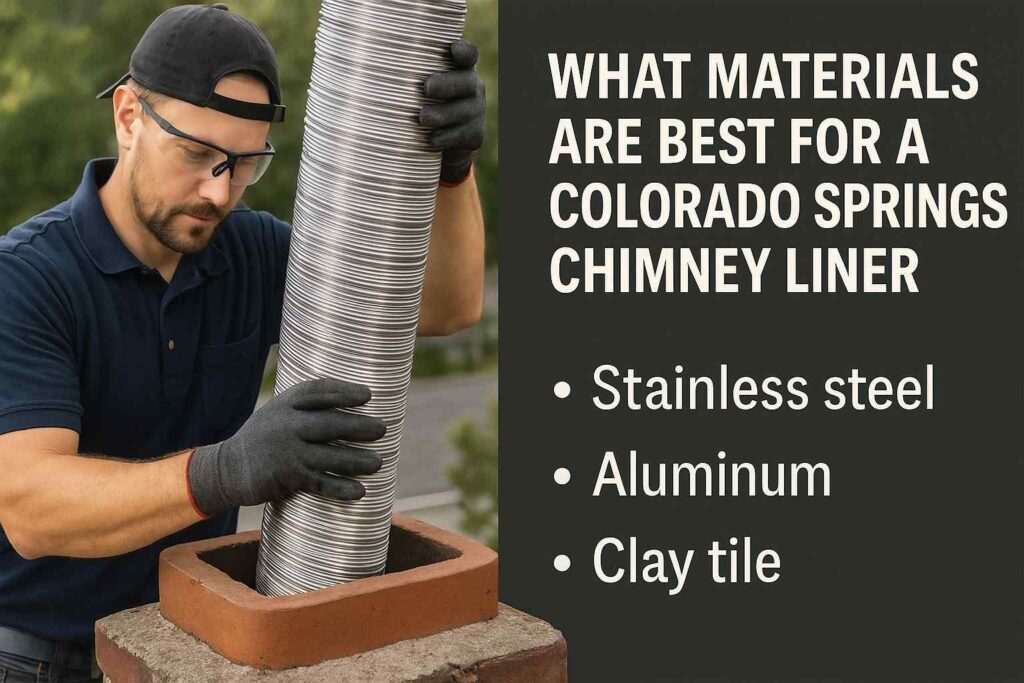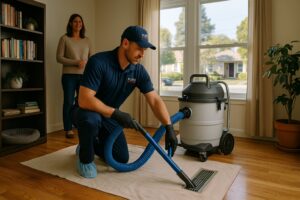
Colorado Springs Chimney Liner
Introduction:
If you’ve ever stared at your fireplace, feeling the warmth and watching the flames flicker, you probably didn’t think much about what’s hiding inside the chimney. But deep inside that structure is something incredibly important—a chimney liner. It might not be the flashiest part of your home, but it plays a huge role in how safely and efficiently your fireplace works. Now, if you’re in a place like Colorado Springs, where winters are cold and fireplaces work overtime, choosing the right liner material becomes even more critical for your comfort and safety in a Colorado Springs Chimney Liner.
1. Stainless Steel: The Go-To for Modern Homes
When it comes to chimney liners, stainless steel tends to steal the show—and for good reason. It’s tough, it doesn’t rust easily, and it handles heat like a champ. Think of it as the all-weather jacket for your chimney. It doesn’t matter if you’re burning wood, gas, or oil—this material adapts.
Key Features:
-
Works with most fuel types
-
Holds up well against extreme temperature changes
-
Easy to install in older or damaged chimneys
Safety:
Because it doesn’t crack or corrode easily, stainless steel reduces the risk of harmful gases (like carbon monoxide) leaking into your home. That’s especially important in Colorado Springs, where homeowners often seal their homes tight against the cold.
Cost:
It’s not the cheapest option, but it’s also not outrageously expensive. Most people find it a smart investment because it lasts for decades with minimal maintenance.
Emergency Service:
If your chimney liner gets damaged, stainless steel liners are quick to replace. Some professionals even offer same-day emergency relining in cities like Colorado Springs.
2. Clay Tile Liners: Old-School but Still Around
Now, if your home was built a few decades ago, there’s a solid chance it has a clay tile liner. These are made from—you guessed it—fired clay. They’re pretty common in older Colorado Springs neighborhoods, and they do the job… to a point.
Key Features:
-
Affordable
-
Fire-resistant
-
Can last 20–30 years if properly maintained
Safety:
Clay tiles are fire-safe but prone to cracking if the temperature changes too quickly (like when lighting a fire on a freezing day). Cracks can let dangerous gases or heat escape into your walls.
Cost:
These are often the cheapest option up front, but repairs can be pricey and frequent if the liner is aging or damaged.
Emergency Service:
Unfortunately, clay tile liners aren’t quick fixes. If there’s serious damage, you might be looking at major work or even a complete replacement.
3. Cast-in-Place Liners: Concrete for Chimneys
Think of cast-in-place liners as giving your chimney a custom concrete sleeve. These are poured right into the chimney, filling every little gap and crack. It’s like giving your chimney a second skin, tailored perfectly.
Key Features:
-
Great insulation
-
Strengthens old or deteriorating chimneys
-
Works well with open fireplaces and wood stoves
Safety:
These liners create a seamless channel, so no gaps mean fewer chances for smoke or gases to sneak through the structure. In cold, dry Colorado Springs winters, that matters.
Cost:
Cast-in-place liners are more expensive and time-consuming to install. But their durability and safety features can make the higher price tag worth it.
Emergency Service:
Due to the custom process, you won’t find a quick fix here. Repairs are more involved and usually not suited for urgent, same-day service needs.
4. Aluminum Liners: Budget-Friendly but Limited
If you’re using a gas appliance and trying to stay within a tight budget, an aluminum liner might be on your radar. But tread carefully. These liners have a pretty narrow set of uses and aren’t built for high-heat situations like wood-burning fireplaces.
Key Features:
-
Very affordable
-
Works with gas appliances
-
Lightweight and flexible
Safety:
Aluminum doesn’t hold up well under stress or high heat. It’s not recommended for fireplaces or chimneys that see heavy use, which is pretty common in Colorado Springs winters.
Cost:
Easily the cheapest option. But it’s also the shortest-lived and least versatile.
Emergency Service:
These are easy to replace, but because they wear out quickly, you might end up calling for emergency help more often.
Comparison Table: Chimney Liner Materials at a Glance
| Material | Fuel Compatibility | Durability | Initial Cost | Emergency Replacement | Ideal For |
|---|---|---|---|---|---|
| Stainless Steel | Wood, Gas, Oil | ★★★★★ | $$$ | Fast | Most modern homes |
| Clay Tile | Wood | ★★★★☆ | $ | Slow | Older traditional homes |
| Cast-in-Place | Wood, Oil | ★★★★★ | $$$$ | Slow | Rebuilding worn chimneys |
| Aluminum | Gas only | ★★☆☆☆ | $ | Fast | Budget gas systems only |
FAQs About Chimney Liners in Colorado Springs
Q1: How do I know which liner is right for my chimney?
A: It depends on what kind of fuel you burn, the condition of your existing chimney, and your long-term goals. A chimney professional can do an inspection and help you choose wisely.
Q2: How long does a chimney liner typically last?
A: Stainless steel liners can last over 20 years, clay tiles about the same if maintained well, and aluminum liners only a few years depending on use.
Q3: Can I install a chimney liner myself?
A: Technically yes, but it’s not recommended unless you really know what you’re doing. It’s safer (and usually faster) to have it done by a professional.
Q4: Is a chimney liner really necessary?
A: Absolutely. It keeps toxic gases from leaking into your home and protects the chimney walls from heat and corrosion.
Q5: Do chimney liners help with energy efficiency?
A: Yes! A properly lined chimney drafts better, which helps fires burn cleaner and more efficiently, especially in drafty climates like Colorado Springs.
A Word to the Wise
“A chimney without a liner is like a car without brakes—it might run for a while, but one day, it’s going to cause real trouble.”
That’s something an old-school chimney sweep once told me, and I never forgot it. Whether you use your fireplace daily or only a few times a year, a quality liner is a must-have.
Final Thoughts: Don’t Skip the Liner Talk
So there you have it—clay, steel, cast, or aluminum, each chimney liner material has its own personality, price, and performance level. If you’re living in Colorado Springs, you’ve got a bit more to think about than just staying warm. Safety, long-term value, and how easy it is to get help when something goes wrong should all factor into your decision. A fireplace is meant to bring comfort, not stress—so spend a little extra time choosing the right liner, and you’ll be enjoying the heat without the headaches.
Read More: Colorado Springs Chimney Sweep




